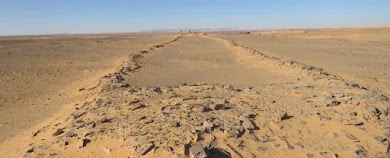Photo credit: Huw Groucutt
In the north of the Arabian Peninsula, bordering the Nefud Desert, archaeologists recently catalogued vast stone monuments dating back 7,000 years. These are called mustatils, meaning “rectangles” in Arabic.
Over 1000 of these prehistoric sandstone walls are found in northwest Saudi Arabia. They are clustered in groups of two to 19 and spread across 200,000 square kilometers (77220. sq miles). Some include small stone shrine houses (betyls) suggesting that these were sites of animal sacrifice to a deity.
The largest mustatil is over 1,500 feet long and consists of 12,000 tons of stone. Recent fieldwork in AlUla and Khaybar Counties, Saudi Arabia, demonstrates that these structures are architecturally complex, featuring chambers, entranceways and orthostates.
A team of archaeologists led by Huw Groucutt of the Max Planck Institute for Chemical Ecology in Germany has been studying satellite images of the southern edge of the Nefud Desert. The team identified and studied 104 new mustatils up close.
First discovered in the 1970s, the purpose of these rectangular structures remains mysterious. One theory is that they are sacred enclosures for ceremonial gatherings and feasts. "Our interpretation of mustatils is that they are ritual sites, where groups of people met to perform some kind of currently unknown social activities," Groucutt said. "Perhaps they were sites of animal sacrifices, or feasts."
Read more here.


Livestock pens?
ReplyDeleteAnd places of the earliest known evidence of animal domestication and animal sacrifice in that region, according to a study published by the researchers in the journal Plos One. https://journals.plos.org/plosone/article?id=10.1371/journal.pone.0281904
ReplyDelete